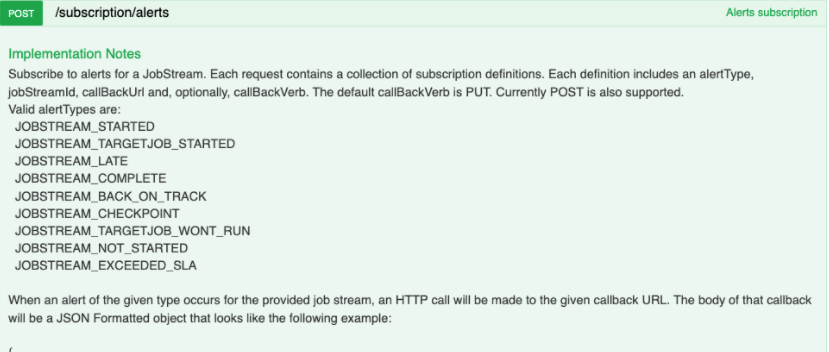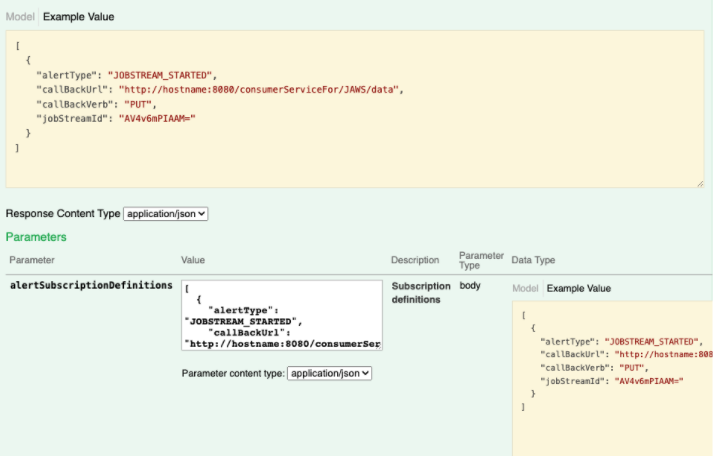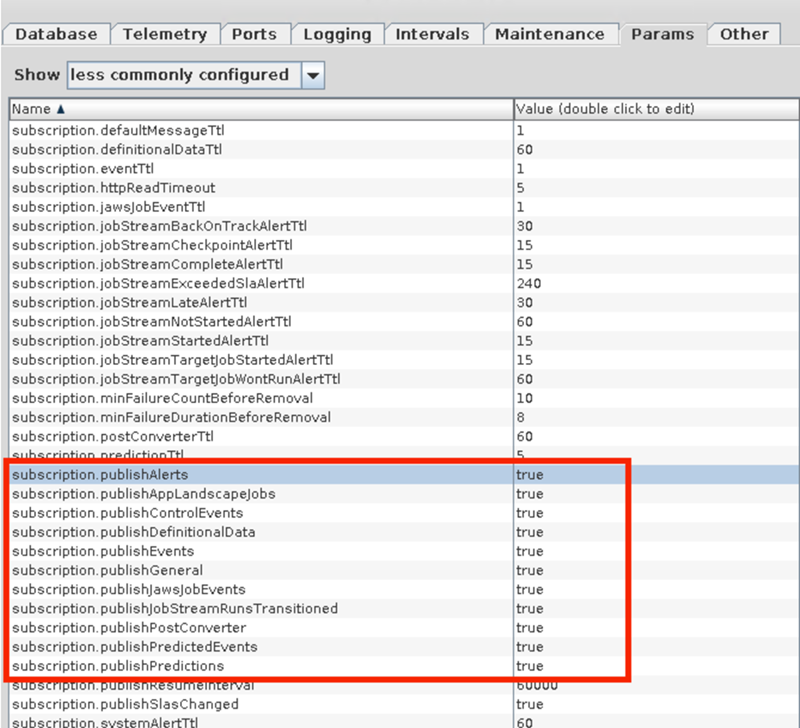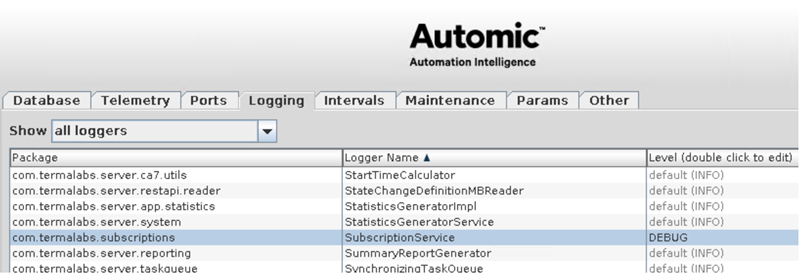REST API Specification for Subscription Services
This topic outlines how to subscribe to information published by Automic Automation Intelligence such as alerts, definitionalData, events and predictions. You can then use these subscriptions to feed the information to other parts of your system.
-
Predictions subscriptions now only require a jobStreamId. JobId and userSuppliedJobStreamId are no longer supported
-
The URL for deletion of a subscription for a subscriptionId now includes a slash just before the subscriptionId
-
All subscriptions are now persisted to a single database table named PubSub_V2
This page includes the following:
API Specification
Use the requests as follows:
-
POST to create a subscription
-
GET to retrieve a subscription
-
DELETE to delete subscriptions
Exception handling
HTTP status codes are generally used to indicate processing results. Whenever practical and useful, details of the error condition are reported back to the caller as a JSON formatted object.
Status Codes
This list describes the most common HTTP status codes and their usage:
-
HTTP 200 - OK
The information you requested should be in the payload
-
HTTP 201 - Created
The request has been fulfilled and a new resource has been created
-
HTTP 400 - Bad Request
When a call does not contain valid input or when an API is not yet implemented. See error detail payload for additional information {Error : unexpected JSON format}
-
HTTP 404 - Not Found
The requested resource is not found in Automic Automation Intelligence
-
HTTP 422 - Unprocessable Entity
For a duplicate subscription
-
HTTP 500 - Internal Server Error
Something unexpected went wrong on the server side. See error detail payload for additional information.
Authentication
Currently, authentication is not required for this API.
Requests
This table describes the generalized subscription endpoints:
| HTTP Verb | Resource | Input | Expected Output (HTTP/1.1) |
|---|---|---|---|
| POST | /v2/subscription/{topic} | {
“callBackUrl” : [String],
“callBackVerb” : [String],
“filter” : {
“key1” : “value1”,
“key2” : “value2”,
.
.
.
}
}
Where:
Note:
Messages are channeled through different topics. The available topics are listed in Appendix A. For more information, see Available Topics. |
Success code: 201 Created Content: {
"subscriptionId" : [String],
"callBackUrl" : [String],
"callBackVerb" : [String],
“topic” : [String],
“filter” : {
“key1” : “value1”,
“key2” : “value2”,
.
.
.
}
}
|
| GET | /v2/subscription/{subscriptionId} | N/A |
Success code: 200 OK Content: {
"subscriptionId" : [String],
"callBackUrl" : [String],
"callBackVerb" : [String],
“topic” : [String],
“filter” : {
“key1” : “value1”,
“key2” : “value2”,
.
.
.
}
}
|
| GET | /v2/subscriptions/{topic} | N/A |
Success code: 200 OK Content: [
{
"subscriptionId" : [String],
"callBackUrl" : [String],
"callBackVerb" : [String],
“topic” : [String],
“filter” : {
“key1” : “value1”,
“key2” : “value2”,
.
.
.
}
},
{ another subscription
},
.
.
.
]
|
| DELETE | /v2/subscription/{subscriptionId} | N/A | Success code: 200 OK |
Data Dictionary
-
callBackUrl
Allowed values: Any valid URL
-
callBackVerb
Optional. PUT is the default if not specified
Allowed values: PUT, POST
-
topic
Allowed values: See Available Topics below
A 404 (Bad Request) response is returned if the topic is not supported
-
filter
Allowed values: See Available Topics below
Available Topics
This table describes the topics and their filter parameters:
| Topic | Filter Parameters | Description |
|---|---|---|
| Alerts | See Swagger documentation |
See Swagger documentation
Note:
Alert content also includes a bestCasePredictedRunEndTime field containing a time if available or “Unavailable” if not |
| Predictions | See Swagger documentation | See Swagger documentation |
| DefinitionalData | See Swagger documentation | See Swagger documentation |
| Events | See Swagger documentation | See Swagger documentation |
| JobRunPredictions | jobId |
Predicted jobRuns for the given jobId. Expected message content: {
"currentStatus" : "Success",
"schedulerId" : "AW1LIB3CXhI=",
"jobId" : "AW1LICjEY3M=",
"isStartTimePredicted" : true,
"jobDuration" : "5:02",
"jobExternalId" : "12999",
"jobStartTime" : "2019/11/20 15:10:14.854 MST",
"jobEndTime" : "2019/11/20 15:15:16.854 MST",
"jobName" : "Hourly_Target",
"schedulerName" : "engautosysr11-01"
}
|
| JobStreamRunsTransitioned | jobStreamId |
JobStream run ids that have changed for the following reasons: because a user deletes a jobstream run, a user rebuilds jobstream run history, a jobstream run has expired, a jobstream run is merged into another jobstream run or when a forecast jobstream run starts running. Expected message content: {
"transitionType" : "TRANSITION_TYPE",
"supercedingJobStreamRunId" : "abcd",
"jobStreamId" : "efgh",
"jobStreamRunId" : "ijkl",
"jobStreamName" : "mkt_price_001"
}
transitionType can be DELETED MERGED REPLACED_BY_REAL_RUN EXPIRED The supercedingJobStreamRunId is included for MERGED and REPLACED_BY_REAL_RUN transitionTypes |
| NptfPredictions | jobStreamId |
What-If predictions for jobRuns that are not expected to finish. Expected message content: {
"schedulerName": "MyAutoSysScheduler",
"jobStreamId": "AV8WnsrKSTE=",
"asOfTime": "2017/10/24 13:16:20.809 MDT",
"jobId": "AV8WnNSlBhE=",
"schedulerId": "AV8WnMqXABo=",
"jobStreamName": "mkt_price_003",
"jobStreamRunId": "AV8WnNSlBhE=",
"jobName": "mkt_price_003",
"jobExternalId": "121",
"jobStartTime": "2017/10/24 13:28:32.931 MDT",
"isStartTimePredicted":true,
"jobEndTime": "2017/10/24 13:32:35.322 MDT",
"jobDuration": "4:02.391"
"currentStatus": "Success"
}
|
| PostConverterNotifications | None |
A signal that the converter has run Expected message content: None |
Enabling the Subscription API
You can subscribe to events on the Swagger JAWS subscriptions page and receive notifications when those events occur.
To Enable the Subscription API
-
Go to the Swagger JAWS subscriptions page at http://<aai hostname>:8080/subscriptionService/swagger-ui.html#/. The list of available subscriptions appears.
-
Select the subscription.
Example
To subscribe to AAI Alerts, on the Swagger JAWS subscriptions page, use POST /subscritptions/alerts.
This screenshot shows its location:

Scroll down to Model Example | Value to enter the subscription definition:

-
Enter the API endpoint that will receive the subscription alerts.
-
In the Configuration Tool enable subscription.* parameters for the subscription you want to receive.
Example
For alerts, enable the subscriptions.publishAlerts parameter:

-
Set the SubscriptionService logger to DEBUG.

-
Verify that the subscriptions are sent by reviewing the subscriptions.log in the /<Install Dir>/jboss/standalone/log directory.
See also: